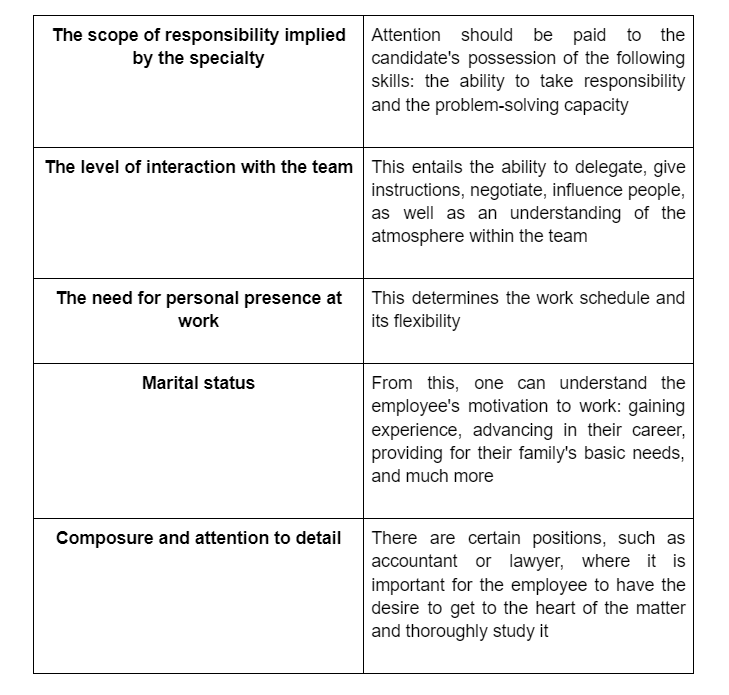Every business relies on its employees, and in this complex mechanism, it is crucial for work to be coordinated, efficient, and profitable. Therefore, every manager eventually begins to ask themselves the question: "Where and how can I find effective employees on mutually beneficial terms?"
The most obvious approach is to either engage a professional recruiter through outsourcing or establish an HR department within the company. However, for many small businesses, particularly those in their early stages, this could create a significant strain on the budget. Therefore, we are here to provide guidance on how such businesses can effectively recruit on their own.
This question hides many pitfalls and nuances, as research from recruiting organizations shows that over 24% of job applicants exaggerate their personal qualities, professional skills, and work experience. It is important not to be misled and to try to discern a person's true potential and professionalism.
In this article, we will delve into the entire process of hiring employees from A to Z:
- How to create a candidate profile
- How to craft a job posting to immediately filter out unsuitable candidates
- How to prepare for an interview and what types of interviews exist
- What to ask during an interview and which questions to avoid
- How to best present your company and leave a positive impression
What kind of employee does the company need?
To start, it's necessary to understand who the company needs: a staff member with limited and clearly defined responsibilities, such as a delivery person, or a unique employee who significantly impacts the overall performance of the company, such as a chief engineer or creative director. In the first case, there are significantly fewer requirements for the person; it is enough that they perform their job duties and meet clearly defined deadlines. Such employees are easily replaceable.
With people from the second category, everything becomes more complicated. These are individuals on whom many processes in the company depend, so their personal qualities, soft skills, and, undoubtedly, professionalism play a key role in their hiring.
There are several universal criteria for creating a comprehensive "portrait" of an employee. By analyzing these criteria, you should understand the skills and abilities that a candidate for the position should possess:

How to place a clickable job posting
When searching for new employees, a crucial step is posting a clear and understandable vacancy that succinctly outlines the responsibilities, conditions, and requirements that will help filter out unsuitable candidates. Here are a few tips on how to place a good job posting:
- Analyze the job postings of other employers: the working conditions and salary should be, if not better, at least not worse than those offered by competitors
- Avoid imprecise and overly creative wordings when describing responsibilities; candidates should clearly understand what is expected of them
- Avoid using template phrases like "sociable, punctual, responsible." Clearly outline what skills you expect from the candidate.
- It is necessary to choose the right time to post the job vacancy. Find a moment when potential candidates will be most interested in the job
Stages of interview preparation
Undoubtedly, the interview is a nerve-wracking stage not only for the job applicant but also for the hiring employer, especially if it's their first time conducting one.
After you have created a candidate profile, outlined the qualities you would like to see in them, and posted the vacancy on a platform, it is time to prepare for the interview.
⏱ Step one
Compose a list of candidates with whom you will conduct interviews. Schedule the time you are willing to allocate for each one: the optimal time is 20-40 minutes, depending on how much you want to delve into the interviewee. It is also advisable to leave a buffer of 15-20 minutes between meetings to form your impression of the candidate and take notes. This will make it easier for you to refresh your memory when making a decision on the position.
📍 Step two
Consider the location for the interview. Perfectly, it should be conducted in the main office or headquarters of the company to present the future employee with the working conditions. However, if this is not feasible or if you prefer a more relaxed setting, any quiet and spacious café would be suitable.
If the meeting format is online, ensure that your surroundings are well-prepared, eliminate any inappropriate noise, and minimize distractions.
🔍 Step three
Just before the meeting begins, it is necessary to review the resume once again, note the key points you wish to focus on, and decide on the appropriate type of interview.
Below are the types of interviews, along with their advantages and disadvantages.
Structured interview

This type of interview is based on a clear structure with a pre-planned interview agenda and carefully crafted questions, minimizing the respondent's need for improvisation.
Many recruiters opt for this interview format due to its predictable nature and ease of administration. However, a drawback can be the formality of rehearsed answers and questions, which may not fully reflect the candidate's expertise.
Stress interview

This interview format is accompanied by stressful factors for the candidate, such as uncomfortable and rapidly changing questions, a lack of time for thoughtful responses, subtle manipulations, and more. The advantage of such an interview is that it reflects how a person behaves in an extreme situation, how quickly they can think and make decisions, and demonstrates their stress tolerance and critical thinking skills. The disadvantage is that this format is not suitable for all positions and specialties and requires serious preparation from the interviewer.
Test interview

The recruiter creates a list of professional competencies required for the position, such as knowledge of a foreign language or programming language, and conducts tests on these subjects. The interview is aimed at evaluating each of the required skills on a scoring scale. This interview format helps to avoid deception and facilitates a realistic assessment of one's professional skills.
Group interview

Group interviews are mainly conducted for mass recruitment, when it is necessary to interview a large number of people while saving time. This interview format consists of the following sections:
Introduction to the company – the facilitator provides information about the company, its corporate culture, and the future position for which the participants are applying.
Introduction of the candidates – the applicants briefly introduce themselves, share their experience, and explain why they want to work specifically for this company. The recruiter may ask clarifying questions.
Task Performance - interview participants solve cases, participate in business games, and act out work situations. The task depends on the company, position, and competencies that need to be demonstrated.
Behavioral interview

In skillful hands, this interviewing technique can be a psychological tool. It does not involve biographical questions about the interviewee and their experience. The interviewer asks general questions and, based on the candidate's responses, draws conclusions about their attitude towards certain situations. For example, "What are the main reasons for misunderstandings in a team?" The question is general, but as practice shows, interviewees often talk about themselves without even realizing it.
The main advantage of this format is that it is difficult for the candidate to understand the true meaning of the conversation, so they respond more sincerely and do not try to pretend. However, this approach also has its own complexities.
For example, there is a rather complex interpretation of the results, which requires a strong theoretical background and extensive practical experience for decryption. Additionally, there is a significant risk of interviewer bias, as sympathy between interviewees in such a dialogue can contribute to the recruiter's bias.
Of course, the best interview is one that combines several types at once, as this allows for a more comprehensive understanding of the candidate and enables evaluation from multiple perspectives.
Where to start the interview?
Once all the intricacies and nuances are clear, you can proceed to the actual interview.
- Introduce yourself to the candidate. As mentioned earlier, interviews can be quite stressful, and the interviewee may easily forget your name and position, even if they remembered it earlier.
- Start with a neutral topic. Give the candidate the opportunity to gather their thoughts and relax, while also aiming to create a positive rapport.
- Explain the format of the meeting: approximate duration and subsequent stages if applicable.
- Avoid interrupting; ask any relevant questions after the candidate has finished speaking. Your task is to assess the candidate's competencies, understand their life priorities, and their problem-solving approach.
Be cautious if the candidate frequently cites financial motivation as an argument, as this can often be a "red flag" during the interview.
🚫 Topics that should not be raised during the conversation with the candidate:
- Religious affiliation;
- Political views;
- Nationality;
- Illnesses and pathologies (only if they significantly affect job performance or pose a safety threat);
- Details of family pans (you can touch upon this topic only in general terms, by asking about marital status, without delving into details);
- Sexual preferences.
⚠️ Important details
Describe the advantages of your company over competitors, the working conditions, career growth opportunities, probation period, and other important aspects of cooperation. However, in the pursuit of the best candidates, do not embellish the working conditions. Remember that "all that is hidden becomes clear"; it is better to present an honest picture of the company's situation.
Thank the candidate for their time and proceed to the analysis. Formulate your impression of the candidate, both as a potential employee and as a person. After analyzing and comparing all candidates, give preference to the best one!
